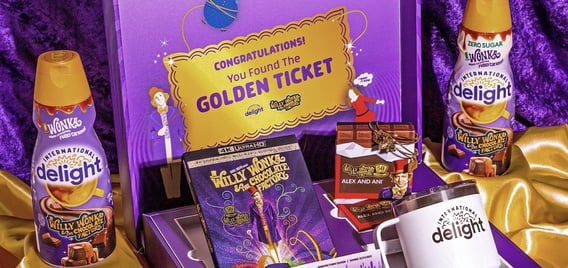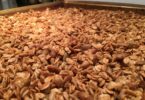Despite an enviable portfolio of iconic billion-dollar brands and widespread recognition, even a well-known company like Hershey sometimes needs a little help reaching consumers.
In early 2020, Hershey, the 128-year-old manufacturer behind brands such as Reese’s and Kisses, identified a market opportunity for healthier chocolate milk as part of an effort to position itself as a bigger player in the burgeoning better-for-you space. What the snack and confections giant needed was a low-risk way to enter the segment. Hershey had the chocolate and Ernie Savo, its head of global licensing, thought New Zealand-based dairy company A2 could supply the milk.
Savo jumped on the phone with A2’s U.S. CEO, Blake Waltrip, to gauge his interest in a brand licensing deal where Hershey would use the company’s name and its proprietary milk, a product that has thrived in an otherwise struggling category by removing a protein known to cause stomach discomfort.
The initial pitch was met with some skepticism by A2 because the proposed co-branded product would be a deviation from the better-for-you, organic and plant-based section of the milk aisle where A2’s products are typically found, formats that Hershey itself isn’t instantly synonymous with, Savo said.
“At first blush the CEO felt I was crazy,” Savo recalled.
Hershey soon came back armed with data showing how the premium milk would fill a consumer need while helping A2 expand its exposure in the store.
“You have a unique point of differentiation in the dairy space but don’t really have a ton of brand awareness as to what A2 is, and I have this amazing chocolate that can make your chocolate milk taste a whole lot better and I need a point of difference in my chocolate portfolio,” Savo told Waltrip at the time.
Eight months later the two sides hammered out a deal. The chocolate milk, which contains 8 grams of protein per serving and eschews artificial flavors, colors and preservatives, hit shelves in the U.S. last month.
From cookies to underwear
Once an afterthought for many multibillion-dollar food and beverage manufacturers, brand licensing deals are rapidly evolving into a lucrative source of revenue for CPGs aiming to grow their business, build equity and maintain or expand a product’s relevancy in an industry beset by mounting competition and changing consumer tastes.
Global sales revenue generated by licensed merchandise and services in food and beverages has steadily climbed from $15.2 billion in 2015 to $16.5 billion in 2019, according to data tabulated by Licensing International. The industry was responsible for about 6% of the $292.8 billion in global sales revenue generated in 2019 across all sectors.
While the ongoing pandemic has upended business operations and made tabulating information since then more challenging, a report released last June by License Global ranked several food and beverage players among its truncated 2020 list of the top 75 companies by global retail sales of licensed and direct-to-consumer products.
Optional Caption
Courtesy of Danone
Hershey was the top food company at No. 24 with licensed products using the company’s brands generating $1.7 billion in sales in 2020. Keurig Dr Pepper was 33rd with $750 million, followed by Diageo, Anheuser-Busch and Jelly Belly.
“There is probably more excitement around the true value this creates more than ever,” Savo said of licensing. “You can get a lot done with a little bit of resource, and therefore it becomes a really nice, a really profitable business.”
In the typical licensing deal, one company agrees to follow certain conditions for the right to use another company’s brand. The licensee then pays a royalty fee that is usually based on sales.
Licensing is divided into two distinct but equally important categories.
The first one expands a CPG’s offerings into adjacent food or beverage categories through a new product. These partnerships tend to prioritize generating revenue for a longer period of time while helping to bring lapsed users back to the brand or connect it with new audiences.
In the second option, which tends to be for a shorter duration, companies link their brand to a cartoon, movie or another opportunity to create buzz, excitement and interest.
Post Holdings, for example, collaborated on a Fruity Pebbles makeup in 2021 inspired by its popular cereal. Danone North America last month partnered with Warner Bros. to launch a pair of International Delight coffee creamers inspired by “Willy Wonka and the Chocolate Factory,” while Mondelēz International’s Oreo brand “took over” the last remaining Blockbuster.
“They have two very different objectives but very important ones,” said Leah Broeders, who oversees licensing at Post’s consumer brands division. “The trick that we try to do is balance between the two, and how do we have that kind of steady drumbeat of those longer-term revenue drives but pulse in some of these fun and expected things in the right times and places?”
“Realistically, it’s not a panacea. … It takes time just like every other function of the business. But it can provide you access you’re never going to get because you’re never going to have an abundance of resources.”

Jeff Dotson
Vice president of strategic brand partnerships, Valen Group
While some deals garner immediate, short-term interest among consumers, licensing agreements can be more than just a quick marketing ploy. They can be an important tool to attract new consumers who might otherwise not get exposed to the brand, or to connect with a younger demographic who will play an essential role in maintaining sales and market relevancy into the future.
Amanda Cioletti, an event and content director for the Global Licensing Group at Informa Markets, said Fruity Pebbles-branded makeup is a way for Post to reach younger consumers who in the past would have been exposed to the cereal during their Saturday morning cartoons. Today, Gen Z consumers are more likely to connect with the brand at their favorite cosmetics store or while spending time on Facebook or YouTube. The makeup also can tug at the heartstrings of adult consumers who grew up with the Flintstones cartoon and the cereal, giving them a sense of nostalgia.
In the food space, few brands have as wide a reach when it comes to brand licensing as Hershey. The company’s licensing portfolio has swelled to more than 150 agreements.
Its Hershey, Reese’s, Kisses, Jolly Rancher and Heath brands are among those that can be found on food products ranging from cookies and muffins to frozen desserts and cereal. In general merchandise, Hershey brands adorn clothing, jewelry, ornaments, puzzles, home furnishings, body and cosmetic products and even underwear.

Optional Caption
Christopher Doering/Food Dive
In some cases, Hershey has prioritized using licensing to own an entire experience. For example, with its chocolate bar associated with making s’mores, Hershey has partnered to broaden its reach with grilling tools used to make the gooey treat, wet wipes to clean up the mess and sandwich bags to hold ingredients preportioned for entertaining in today’s COVID-19 world. It not only provides consumers with solutions, Savo said, but benefits retailers and the company through prominent store displays and higher basket sizes.
CPGs used to lump licensing revenue into their financial results, but now more companies are separating it out to show how much money they are generating and highlighting it to Wall Street analysts and investors during their quarterly earnings reports, said Cioletti. The financial windfall and success licensing provides in helping companies grow their brands is only serving as a catalyst for executives to seek out other partnerships.
“You’re going to see more and more on the shelf at your local grocery store,” Cioletti predicted. “Once [CPG companies] see sales increase, once they have the data to support expansion, they will.”
In addition to creating revenue through product extensions, brand licensing can also provide a lift to core brands.
Post, which has licensed Pebbles for use in ice cream, protein powders, cake mixes and other products, has seen the increased visibility provide a tailwind for the 51-year-old cereal. Brand licensing deals signed by the company during the past few years contributed to the 6.7% increase in sales of Pebbles cereal in 2021, the company said.
Research conducted for Hershey by Numerator in 2019 found when consumers purchased one of the company’s licensed brands like Reese’s Puffed Cereal or a Hershey baking mix — both collaborations with General Mills — shoppers were on average four times more likely to also have purchased a Reese’s or Hershey’s confectionary item during the same shopping trip.
Overcoming product failure
Licensing plays an invaluable role in mitigating the risk that comes with launching a new product. In a CPG category where 85% of products typically fail within two years, according to Nielsen, companies are looking for any way to give themselves an advantage.
Brand licensing is typically faster and less costly than if a company decided to develop a product from scratch, while allowing each partner to piggyback on the benefits of the other — such as a brand name, experience making or marketing a certain product, understanding how to reach a specific consumer and industry connections.
A few years ago, the innovation team at Post noticed an opportunity for a coffee-flavored cereal after conducting research with consumers. But another launch was a risky endeavor after prior iterations created by the manufacturer failed.
The St. Louis company, which has also partnered with Mondelēz on cereals with Oreo, Chips Ahoy! and Honey Maid, determined it could increase its chance of success by “layering on a brand,” said Broeders with Post. It eventually entered into a licensing deal with coffee giant Dunkin’ for Caramel Macchiato and Mocha Latte cereals launched in 2020.
“The Dunkin’ piece of it gave us the reason to try another coffee cereal in the market,” Broeders said, noting it has achieved “very broad acceptance among retailers” after its launch.
By adding another brand to the mix, a food or beverage item has a better chance to reach new customers and demographics or enter previously unexplored sections of the store. Licensing also can act as a point of differentiation by allowing a product to stand out from its competitors.
“Where we see the greatest successes is where you take a brand and you naturally extend it into a category where the consumer will nod their head and say ‘Oh yeah, you’ve always been here, or I recognize this brand, even though the brand hasn’t been there, ‘ ” said Jeff Dotson, vice president of strategic brand licensing at the Valen Group.

Optional Caption
Christopher Doering/Food Dive
With several brands competing for space in frozen food, restaurant chains Red Robin and TGI Fridays have managed to thrive on retail shelves through deals to market their appetizer lineups in the ready-to-bake category, Dotson said. (Conagra Brands, which originally held the Red Robin licenses, passed them on to Lamb Weston as part of its 2016 spinoff of frozen potato maker, while Kraft Heinz oversees much of TGI Friday’s store products.)
In the case of Red Robin, Dotson said the chain’s steak fries and onion rings “seamlessly translated to retail” and are viewed by shoppers as “authentic” as those they would purchase at the restaurant. Retail sales are now estimated to be more than $40 million annually, with both products leaders in their respective categories, he said.
Maintaining a copacetic relationship
While licensing deals can lead to lucrative payouts or broader appeal for a product, they can be difficult and time-consuming to put together and equally as hard to follow through. The business partners need to manage royalties generated from the product, make sure they are complying with the deal’s requirements and approve all aspects of the product line, including packaging and marketing.
“Realistically, it’s not a panacea. … It takes time just like every other function of the business,” Dotson said. “But it can provide you access you’re never going to get because you’re never going to have an abundance of resources.”
Jel Sert, a manufacturer of Wyler’s Light Drink Mixes and Fla-Vor-Ice freezer pops, has partnerships with industry heavyweights such as Coca-Cola, Mars Wrigley, Hershey and Sonic Drive-In to produce freezer bars and drink and dessert mixes.
“It really is a lot of work to care for the partnerships and we have all the compliance integrated into every department,” said Nancy Samani, Jel Sert’s vice president of licensing. “Everyone just understands how to manage a licensing relationship. It’s a critical part of our marketing strategy, our growth strategy, the way we do business.”
Brand licensing enables the 96-year-old Jel Sert to quickly enter a new or under-penetrated category and reach shoppers by taking advantage of a product that already has widespread recognition and consumer affinity. A licensed brand helps Jel Sert get immediate national distribution in big retailers such as Walmart, Dollar General and Walgreens, Samani said, giving it a similar heft to that of its larger and deeper-pocket CPG competitors.

Optional Caption
Permission granted by Jel Sert
In pitching a partnership, she said Jel Sert highlights its licensing experience and market-leading position in its categories, as well as the company’s ability to get products to market faster due to its manufacturing facilities and in-house R&D department. Jel Sert comes armed with reams of data highlighting prior licensing deals it can use as a selling point — including potential royalties and the benefit to the core brand.
“Licensing is a big part of what we do in building our business,” Samani said. “But I think we’re also really important to our licensors because of the volume of sales we are able to achieve for their brand and the recognition that we can further [grow] their brands.”
Finding the right partner
Even for companies that are licensing veterans, lining up a deal can be an arduous process.
When Conagra Brands uncovers an opportunity not being met by an existing product, the maker of Duncan Hines, P.F. Chang’s frozen meals and Slim Jim will draft a rough outline of a potential solution’s ideal attributes, packaging and even how it could be marketed. The roadmap helps executives determine if the company could create the product through one of its own brands, or if it would be better to partner with another CPG.
“Borrowing equity sometimes makes sense, especially if we are really trying to create a new flavor or get into a new aisle or really kind of take another brand and apply it to ours for reasons to make it more contemporary or cooler or more buzzworthy.”

Ashley Lind
Senior director of predictive demand science, Conagra Brands
In finding a partner, Conagra combs through retail data to look at the household penetration of the prospective brands, their growth trajectory and whether bringing the two items together would make sense. The food manufacturer has struck a number of high-profile deals in recent years for some of its biggest brands, including with Coca-Cola for Snack Pack Fanta Gels and General Mills for Cocoa Puffs cereal that contains Conagra’s Swiss Miss hot cocoa mix.
“Our charge is to really make sure that our brands, a lot of them being iconic, are fitting what consumers want today,” said Ashley Lind, senior director of predictive demand science at Conagra. “Borrowing equity sometimes makes sense, especially if we are really trying to create a new flavor or get into a new aisle or really kind of take another brand and apply it to ours for reasons to make it more contemporary or cooler or more buzzworthy.”
In 2019, Conagra’s demand science team watched as at-home bakers, restaurants and foodservice establishments created over-the-top mashups such as rainbow cereal-infused cheesecake, bars, cookies and cakes. Even as web searches, Pinterest posts and other data showed this was gaining momentum, another trend was emerging too: Social media posts indicated people were often failing and their ideas didn’t always turn out as planned. They needed help.
“We knew there was this opportunity, a problem that people were trying to solve,” said Lanie Friedman, Conagra’s senior director of brand communications.

Optional Caption
Permission granted by Conagra Brands
After looking at the top 15 or so leading cereal brands, Conagra settled on Post’s Fruity Pebbles with its bright colors, signature taste and strong category position. Pebbles has been an anomaly in an otherwise downtrodden cereal market, grabbing the most market share out of any cereal brand in 2021 and recording eight straight years of growth, according to data provided by Post.
Last summer, Conagra launched Duncan Hines Epic Baking Kits with Fruity Pebbles that featured the cereal as a batter mix-in, frosting flavoring and as a topping. The baking mix has posted a “solid” return since its debut, according to Conagra, with Epic Fruity Pebbles ranking as the top-selling new item in the baking category in 2021.
“Licensing is something we’ve definitely embraced because it’s a way to drive news and another lever to make our brands more contemporary and interesting,” Friedman said. “We’ve got a really strong core and so we look at co-brands as extensions to incremental growth.”
Pressure to succeed
For other CPGs, licensing can aid in refreshing an aging product or help it become associated with attributes popular with choosey consumers, such as sustainability or health benefits, further boosting the brand’s credibility and reputation. For a brand in a stable, mature market, even a scant half a percent gain in market share can generate tens of millions of dollars in additional revenue.
“There’s pressure around organizations, pressures in terms of cultural shifts, which are changing consumer expectations. This leaves many portfolios of products exposed … in terms of the investment required, the skills required and the time required to adapt,” said Lee Powney, a senior partner with Vivaldi, whose firm has worked with companies including Coca-Cola and AB InBev. “I see licensing playing a very interesting role in augmenting existing portfolios.”
It’s a big reason why Hershey has doubled down on bringing its signature chocolate brand into other food categories. Savo said chocolate is present in a lot of places beyond confections and if Hershey was absent in those spaces, it could end up hurting the brand.

Optional Caption
Courtesy of Barefoot Wine
“While we’re still the leader as a chocolate bar, our leadership position has the ability to start to wane as consumers start to think of chocolate more genetically versus chocolate at Hershey,” Savo said. “And so we do insert ourselves everywhere where chocolate is a big component of it.”
Licensing is not without its risks. Companies that let another business use their brand naturally have to cede some control over how the items are produced, distributed and marketed — a struggle for executives who are accustomed to overseeing every aspect of the process. There also is the possibility of blowback if the new product is involved in a food safety recall or one of the partners gets embroiled in a scandal.
Companies “leave a lot on the table” when it comes to brand licensing, Valen Group’s Dotson said. “There’s a lot of things out there that I think strategically get passed on very early because people are managing risk in a way that isn’t really about risk. It’s about not making a mistake.”
As licensing gains momentum, there is a possibility that companies overextend a brand’s reach into too many areas, enter into deals so far removed from their core category or business that they sow confusion among consumers, or develop products that simply don’t catch on.
Even as Post readies for more Pebbles licensing deals in 2022, Broeders said the company is carefully watching to ensure that any opportunities enhance brand equity rather than dilute it. Many product extension ideas for Pebbles never gain much traction at Post, including a brief discussion a few years ago about moving it into alcohol.
“Every time you turn around, it’s like what’s the next thing brands are partnering on? … I think what becomes key in these situations is making sure that you’re making smart decisions and not saying ‘yes’ to everything,” said Broeders. “Sometimes saying ‘no’ might be the more strategic decision.”








